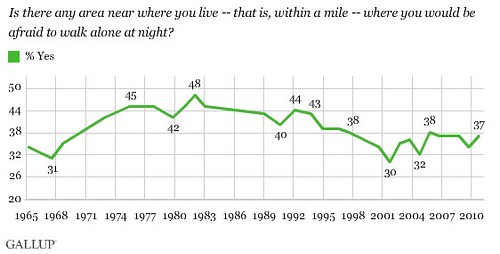Gallup: nearly 4 in 10 Americans fear walking alone at night

Posted November 10, 2010 at 1:29PM
As we have written here before, in order for our communities – particularly cities – to succeed as sustainable places, we need to address issues such as education and perceived safety, even though they are not traditionally regarded as “environmental.” A new poll from Gallup confirms the latter. While the fact of crime has decreased sharply in the last two to three decades, the perception is lagging behind:
“The proportion of Americans afraid to venture out alone at night near their home is lower today than at points in the past, when the crime rate was significantly higher than it is today -- such as in 1982 and 1993. However, it has not decreased as sharply as the drop in violent crime over the past decade. In fact, while the violent crime rate has dropped steadily each year and now stands at a record low, the percentage afraid to walk alone at night has rebounded somewhat, suggesting fear of crime is not necessarily dictated by reality. The degree to which media portrayals of crime factors into these perceptions, and how aware Americans are of the declining crime rate, is unclear.”
Adults living in low-income households are roughly twice as likely as those living in high-income households to be afraid, and women are more than twice as likely as men to say they are afraid to walk alone at night near their home. For more about the Gallup poll, go here.
Related to a fear of being safe while walking is a fear of using public transportation. Yonah Freemark writes in The Next American City:
"A large percentage of the population is afraid to jump on a bus or a train. This undeniable fact is a major explanation for the limited mode share of public transportation in most American cities. In short, when people get into their private automobiles, they feel at ease doing so because they will not have to interact person-to-person with other people who could potentially be dangerous. The same cannot be said of transit . . .
"A new study by Nilay Yavuz and Eric Welch of the University of Illinois at Chicago suggests that these feelings are widespread and affect both men and women of all ethnic groups. The act of making oneself vulnerable in the public sphere is difficult to take not only for the most marginalized groups like the disabled and the elderly, but also for pretty much everyone else. People working in the transit field must remember that reducing fear of crime can play an essential role in promoting a sense of comfort among everyday riders."
Studies show that actual crime on transit and within transit stations and facilities is rare. But that doesn't account for the probablility that much of the fear of "transit" crime includes fear of crime approaching or leaving those facilities, in surrounding areas. Freemark concludes: "If we want our transit systems to be safer, we have to make the neighborhoods that surround them safer."
Move your cursor over the images for credit information.


